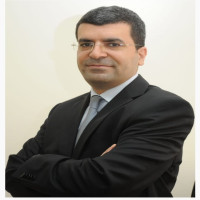Research Articles
Review
Case Report
Issue Editorial Board

He graduated from Hacettepe University Faculty of Medicine (Eng) in 2008. He completed his PhD in Medical Physiology at Gaziantep University Faculty of Medicine, Department of Physiology in 2018. He has been working as a faculty member at Gaziantep Islamic University of Science and Technology, Department of Physiology since 2019. His main research areas are Alzheimer's Disease, exercise and electrocardiography.








Aim & Scope
Experimental and Applied Medical Science aims at being a current and easily accessible academic publication in which striking research results that will improve the quality of life and are unique from every field of medical sciences.
Experimental and Applied Medical Science is an open-access, internationally double-blind peer reviewed academic medical journal which is published in English four times a year, under the auspices of Medical Faculty of Gaziantep Islam Science and Technology University. The journal receives manuscripts for consideration to be publishing in the form of research articles, reviews, letter to editor, brief notification, summary notification etc. which could have been presented from within the country or abroad and including experimental animal studies related to the pathogenesis of diseases, pharmacological, clinical, epidemiological and deontological studies, also studies in the fields of improving public health, health services or health insurance.
During evaluation or publication no charge is demanded from authors. The journal is published every 3 months (March, July, September and December) with 4 issues per year. The written language of the journal is English. Abstract part of the manuscript only should also be submitted in Turkish.
Author Guidelines
Experimental and Applied Medical Science accepts original research articles, reviews, case reports, and letters to the medicine and health sciences editor. Submission of an article will imply that it has not been previously published and is not being considered for publication elsewhere. The decision to publish manuscripts submitted to Experimental and Applied Medical Science will be based on the Editorial Board's opinion on the importance and originality of the work.
All authors (corresponding author and other authors) of manuscripts submitted to the journal should obtain an individual ORCID (Open Researcher and Contributor ID) number from http://orcid.org and indicate this number on the manuscript's title page.
The corresponding author should add all authors to the DergiPark system.
Articles
Manuscripts should be written electronically in "Microsoft Word" format, in "Times New Roman" font, 12-point font size and double-spaced. Articles should be written in English. Abstracts should be written in both Turkish and English. There should be 2.5 cm margins on both sides of the page and the text should be justified. Words should not be hyphenated. Pages should be numbered sequentially.
The manuscript should include "Title page", "Turkish Abstract", "English Abstract", "Text", "References", "Tables" and "Figures" sections, each of which should start on a separate page.
For original research articles, the necessary ethics committee permissions must be obtained and the ethics committee number and date must be indicated in the manuscript. The plagiarism report of the study should be uploaded and the plagiarism rate should not exceed 30%.
When uploading your article to the system, use the name and surname of the corresponding author as the file name.
Title Page
Turkish and English titles should be given separately. Abbreviations should not be used in the title.
ORCID (Open Researcher and Contributor ID) number for all authors, abstract, and text (excluding abstract, tables, and references) word count should be added to this page.
Authors' full names, surnames, academic titles, institution of employment, the full name and address of the clinic/department/institute/hospital/university where the study was conducted, e-mail addresses of all authors should be indicated and supernumerary numbering should be used for each author.
The current address, e-mail address, and contact phone numbers (GSM phone number must be given) of the author responsible for the communication of the article should be added to the title page. If the study has been previously presented as a paper at any scientific meeting or if the abstract has been published, it should be indicated on this page. All potential conflicts of interest and financial support of all authors, whether or not directly related to the subject of the manuscript, should be individually disclosed and indicated on the title page.
The contributions of all authors to the manuscript (study hypothesis, design, management, data collection/processing/analysis/interpretation, literature search, provision of facts/equipment, writing, reviewing, and others) should be indicated separately on this page.
e.g: XXX YYY: Study hypothesis, management
XXX YYY: Data collection/processing
In the case of human cases or animal use, the name of the Hospital Ethics Committee or Research Ethics Committee should be indicated on the title page and in the methods section.
Abstract
Abstract text and title should be prepared in Turkish and English. Abstracts in both languages should not exceed 250 words. The Turkish abstract should consist of “Amaç”, “Yöntem”, “Bulgular”, “Sonuç” and “Anahtar Kelimeler”; and the English abstract should consist of "Purpose", "Methods", "Results", "Conclusion" and "Keywords". Turkish and English abstracts and keywords should be identical. Case summaries should be prepared as a single paragraph without a title. Abbreviations should be avoided as much as possible in the abstract. Keywords should consist of at least 3 and at most 4 words. Keywords should be selected from the MeSH (Medical Subject Headings, http://www.nlm.nih.gov/mesh/MBrowser.html) list. At the same time, your keywords should also be included in the Turkish Science Terms (http://www.bilimterimleri.com).
Text
It should consist of "Introduction", "Method", "Results", "Discussion" and "Conclusion" sections. "Conflict of interest" and "Acknowledgments" sections should be included at the end of the text.
Avoid using too many abbreviations in the text. All abbreviated terms should be indicated in parentheses at the first occurrence in the text. Words abbreviated in the abstract section should be abbreviated again in their long-form at the first occurrence in the text. Abbreviations should be in the form of standard expressions.
Introduction
The subject of the study, its purpose, and literature information should be specified.
Method
Research methods and tools used in this chapter should be presented in clear and concise descriptions with references. The source of all equipment should be identified as the supplier, city, state/country. The chemical name of any drug should precede its trade name. In articles describing animal experiments, the type, species, sex, age, supplier, and the number of animals used should be specified. An ethical statement on the use of animals or details of ethical approvals, consents, and recruitment of human subjects should be clearly stated.
Statistical analysis should be indicated as a subheading at the end of this section. Statistical measures of variation in text, illustrations and tables should be described. All sub-superscripts and unusual characters should be indicated.
Results
This section should present the results of the study. Data should be presented clearly, preferably in tables or figures. The number of tables should not exceed 5 and the number of figures should not exceed 3.
Discussion
In this section, the conclusions drawn from the findings and the current literature should be discussed and interpreted together. Statistical results used in the findings should not be repeated in this section. At the end of the discussion section, the limitations should be stated under the subheading "Limitations".
Conclusion
This section should be one paragraph. The discussion should include the contribution of the results to the field and the clinical message.
Acknowledgment
People and organizations that supported the study can be thanked in this section.
Conflict of Interest
All potential conflicts of interest and financial support of all authors, whether or not directly related to the subject of the manuscript, should be individually disclosed and indicated on the title page.
References
References should be designed in 'Vancouver' style and numbered according to the order of occurrence in the text. If more than one and consecutive number of references are given; it should be written as 15-18. Unpublished observations and personal interviews should be avoided. Multiple authors should be separated with commas. If there are more than three authors, "et al." should be added after the third author without commas for article and book references. If a chapter in a book is cited and there are multiple authors for this chapter only, the title and chapter of the book should be indicated, the first three authors of the chapter should be written, and "et al." should be added for the following authors. Journal names should be abbreviated as used in Index Medicus. The abbreviation used for our journal is "EAMS".
The number of references should not exceed 40 for research articles, 20 for case reports, 100 for reviews and 10 for technical notes/letters to the editor.
For example:
1. Perell KL, Nelson A, Goldman RL, ve diğerleri. Düşme riski değerlendirme önlemleri: analitik bir inceleme. Gerontoloji Seri A, Biyolojik bilimler ve tıp bilimleri dergileri. 2001;56(12):M761-6.
2. Ha H, Han C, Kim B. Obezite Depresyona Neden Olabilir mi? Bir Sahte Panel Analizi. Koruyucu hekimlik ve halk sağlığı dergisi = Yebang Uihakhoe chi. 2017;50(4):262-7.
3. Çekmen MB, Turgut M, Türköz Y, et al. Nitrik Oksit (NO) ve Nitrik Oksit Sentaz (NOS)'ın Fizyolojik ve Patolojik Özellikleri. Türkiye Klinikleri Journal of Pediatrics. 2001;10(4):226-35.
4. Parlakpınar H, Örüm MH, Acet A. Kafeik asit fenetil ester (KAFE) ve miyokardiyal iskemi reperfüzyon (Mİ/R) hasarı. İnönü Üniversitesi Sağlık Bilimleri Dergisi 2012; 1: 10-5.
5. Yıldırım AB. Maternal hipotiroidizmin postnatal sıçan testislerinde sitokrom p450 aromatazın immünoreaktivitesi üzerine etkileri. 2015; Doktora tezi.
6. . https://hsgm.saglik.gov.tr/depo/birimler/kanserdb/istatistik/Trkiye_Kanser_statistikleri_2016.pdf (Son erişim tarihi: 21.09.2020).
7. Kuran O, İstanbul, Filiz Kitabevi. Sistematik Anatomi. 1983 p. 76-9.
8. Abbas AK, Andrew H Lichtman, Shiv Pillai. Hücresel ve Moleküler İmmünoloji. 6. baskı. Philadelphia: Saunders Elsevier; 2007 s. 121-56.
Tables-Graphs-Figures-Pictures
All tables, graphs, figures, and pictures should be placed on separate pages after the references. Tables should be set vertically in the text. Tables should be borderless, and have a line line and no column line. Tables should be inserted from the "Insert Table" section in Word, each double-spaced. Mean and Standard Deviation values (X±SD) given in the tables should be in the same column. Percentage values (n(%)) should be in the same column in tables. Decimal numbers should be given as 2 digits after the comma in the text and tables. All Graphics, Figures, and Pictures used in the text should be named Figures. Tables should be named Table. All figures and tables used should be indicated in the text. They should be numbered according to the order of occurrence in the text and a short title should be written. The titles of the tables should be written above the table and the titles of the figures should be written below the figure. Abbreviations and statistical methods used in tables must be explained at the bottom. Figures should be prepared with the 'jpeg' compression technique and each figure should be saved in a separate file. Figures should be at least 9×13 cm in size and 600 dpi resolution. Images should have a minimum resolution of 300 dpi and only be sent separately as TIFF or EPS files. In pictures where the patient's identity can be recognized, the signed consent of the patient or his/her legal representative must be attached to the submitted letter, otherwise, the names or eyes of the person or persons in question must be covered with "tape".
Note:
We accept electronic supplementary materials to support and enhance your scientific research. Supplementary files offer additional possibilities for publishing author-supporting applications, movies, animation sequences, high-resolution images, background datasets, audio clips, and more.
Conflict of interest and financial support must be disclosed at the time of submission. Authors are responsible for notifying the journal of any additional conflicts of interest or financial support that may arise before the publication date of their manuscript. All authors must individually disclose all potential conflicts of interest and financial support, whether or not directly related to the topic of their article.
Reviews
Reviews that fall within the scope of the journal will be evaluated.
Case Reports
Rare and important clinical experiences should be presented. Includes introduction, case, and discussion sections.
Letters to the Editor
The letter should be 1000 words (or 750 words and one table or figure) and 5 references. Letters are published upon the decision of the Editorial Board. Authors should contact the Editorial Office (https://dergipark.org.tr/tr/pub/eams.) before submitting their letters. Letters commenting on published articles should be submitted within six months after publication; the letter will be sent (if necessary) to the author for reply.
Scientific Letters
These manuscripts are preliminary papers that aim to announce clinically important data and discoveries. The text has no sections; it consists of a maximum of 1000 words, one table or figure, and a maximum of 10 references. Letters are published with the decision of the Editorial Board. Authors should contact the Editorial Office (https://dergipark.org.tr/tr/pub/eams.) before submitting their letters.
Ethical Principles and Publication Policy
Manuscripts are only considered for publication provided that they are original, not under consideration simultaneously by another journal, or have not been previously published. Direct quotations, tables, or illustrations that have extracted from any copyrighted material must be accompanied by written authority for their use from the copyright owners. All manuscripts are subject to review by the editors and referees. Deserving to be publishing is based on significance, and originality of the material submitted. If any manuscript is considered to deserve publishing, it may be subject to editorial revisions to aid clarity and understanding without changing the data presented.
Experimental and Applied Medical Science strictly adheres to the principles set forth by “Helsinki Declaration” whose web address is below.
https://www.gibtu.edu.tr/Medya/Birim/Dosya/20210525133548_b192cec0.pdf
Editorial Board declares that all reported or submitted studies conducted with “human beings” should be in accordance with those principles.
Manuscripts presenting data obtained from a study design conducted with human participants must contain affirmation statements in the Material and Methods section indicating approval of the study by the institutional ethical review committee and "informed consent" was obtained from each participant. Also all manuscripts reporting experiments in which laboratory animals have been used should include an affirmation statement in the Material and Methods section validating that all animals have received human care in compliance with the “Guide for the Care and Use of Laboratory Animals” whose web address is below and reveal approval by the institutional ethical review board.
https://www.gibtu.edu.tr/Medya/Birim/Dosya/20210818130308_dca61056.pdf
If there is a commercial relation that contributes to the study process or there is an institution that provides financial support for the study; the authors must declare that they have no commercial relationship with the commercial product, drug, company used, or what kind of relationship (consultant or any other agreement) they have, if any.
Processing and publication are free of charge with the journal. No fees are requested from the authors at any point throughout the evaluation and publication process. All manuscripts must be submitted via the online submission system, which is available at https://dergipark.org.tr/tr/pub/eams. The journal guidelines, technical information, and the required forms are available on the journal’s web page.
All expenses of the journal are covered by the Medical Faculty of Gaziantep Islam, Science and Technology University. Potential advertisers should contact with the Editorial Office of the journal. Advertisement images are published only upon the Editor-in-Chief’s approval.
Statements or opinions expressed in the manuscripts published in the journal reflect the views of the author(s) and not the opinions of the Medical Faculty of Gaziantep Islam Science and Technology University, editors, editorial board, and/or publisher; the editors, editorial board, and publisher disclaim any responsibility or liability for such materials.
All manuscripts involving a research study must be evaluated in terms of biostatistics and it must be presented altogether with appropriate study design, analysis and results. p values must be given clearly in the manuscripts. Other than research articles, reviews, case reports, letters to the editor, etc. should also be original and up to date, and the references and, if any, their biostatistical parts should be clear, understandable and satisfactory.
The publication language of the journal is English. In addition, the abstract part of the article must be uploaded in both Turkish and English. Manuscripts should be evaluated by a linguist before being sent to the journal.
All manuscripts and editorial correspondence must be submitted online to the editorial office, https://dergipark.org.tr/tr/pub/eams.
According to the Law on Intellectual and Artistic Works, which was first published in the Official Gazette with the law number 5846 on 13/12/1951, whose web address is below, and on which subsequently various changes have been made or novel parts have been added in time, all kinds of publication rights of the articles accepted for publication belong to the institution that published the journal. However, the thoughts and suggestions in the articles are entirely the responsibility of the authors.
https://www.gibtu.edu.tr/Medya/Birim/Dosya/20210818145630_406d24df.pdf
Price Policy
The article evaluation and publication process in Experimental and Applied Medical Science journal is completely out of any charge.




